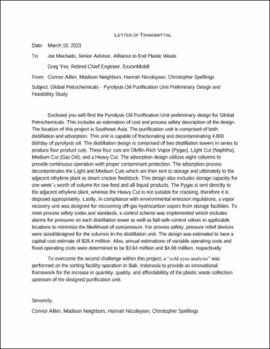| dc.description.abstract | The objective of this study was to design a process unit that fractionates and purifies a stream of pyrolysis oil derived from pyrolyzed plastic waste to meet the specifications for feedstock to an adjacent ethylene plant for Global Petrochemicals. The location of this study was in Indonesia, Southeast Asia. The purpose for the study emerges from the idea that the economy surrounding plastics and their usage should be circular. The collection of plastic waste should be managed in a way that reduces environmental impacts and creates a closed loop for the recycle and reuse of plastics. To address the problem of plastics waste management, the design of a purification unit achieves the goal of successfully adding to the growing topic of a circular economy. Additionally, it diversifies the portfolio of feed sources to Global Petrochemicals' ethylene plant. This design prioritizes several important design considerations which includes process safety, environmental impacts, energy efficiency, and flexibility. The designed purification unit incorporates both distillation and adsorption. This unit is capable of fractionating and decontaminating 4,800 bbl/day of pyrolysis oil with an overall yield of 86% by mass. The distillation design is comprised of two distillation columns in series with a system of eleven heat exchangers; two of which utilize heat integration to minimize utility usage. This process produces four specified cuts, which are Pygas (Olefin-Rich Vapor), Light Cut (Naphtha), Medium Cut (Gas Oil), and Heavy Cut. The adsorption design utilizes eight columns to provide continuous operation with proper contaminant protection. The adsorption process decontaminates the Light and Medium Cuts which are then sent to storage and ultimately to the adjacent ethylene plant as steam cracker feedstock. The Pygas is sent directly to the ethylene plant from the distillation with no further processing. Since the Heavy Cut is not suitable for cracking, it is appropriately disposed of through options, such as, selling it to a third party as a contaminated atmospheric residue or sending it to a third party for waste management. The designed purification unit includes one week of storage for all liquid products and feeds with proper emission control measures by incorporating a designed vapor recovery unit to recover overhead hydrocarbon vapors from storage vessels. The capital cost of this project was estimated to be $28.4 million with annual estimations of variable and fixed operating costs of $3.64 million and $4.68 million, respectively. These costs include all installed equipment with additional added costs for contingency and potential fees. Also accounted for in these estimates is the cost of operational labor, with an estimated requirement of 16 operators, based on the size of the unit. A "cold eyes analysis" was also performed on the sorting facility operation in Bali, Indonesia to provide innovative ideas that increase the quantity, quality, and affordability gaps of collecting plastic waste. To ensure its long-term contribution to the business, the utilization of tourism and technology were determined to be primary avenues to close these gaps. Additionally, coupled with the implementation of waste banks, local communities could be provided with additional sources of income to help grow the local economy, ultimately leading to better waste stewardship. | |
